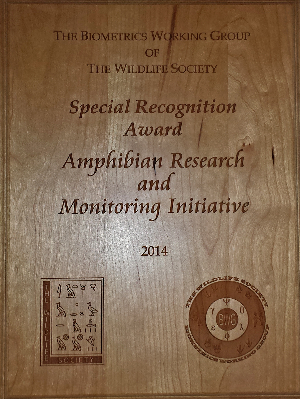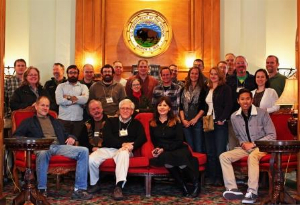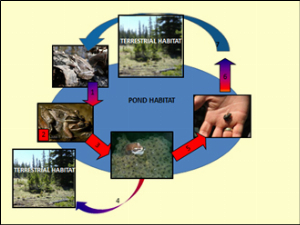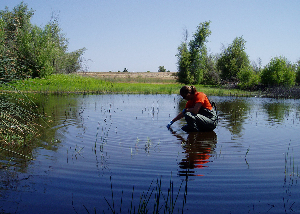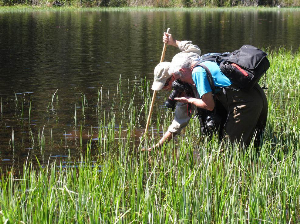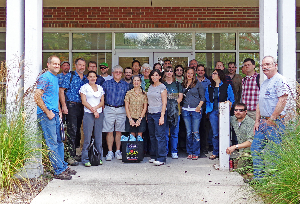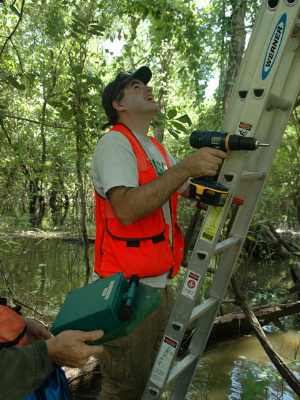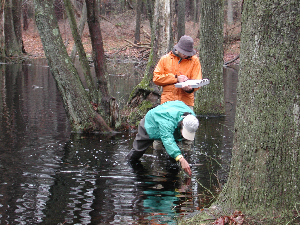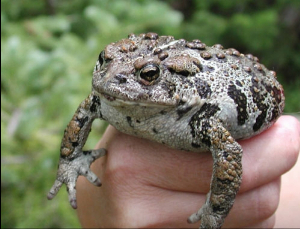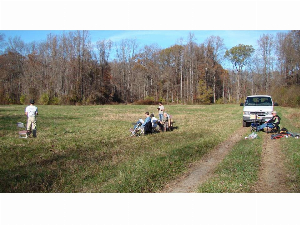Search ARMI Database
Search term(s)
Contribution Number
Search Results
91 record(s) found.
News & Stories ARMI recognized!
The 2014 Special Recognition Award from The Wildlife Society's Biometrics Working Group was presented to the Amphibian Research and Monitoring Initiative. The award is meant to recognize a group or an individual that has made an outstanding contribution to the development and application of quantitative methods to the fields of wildlife science and management. This year the award is presented to the Amphibian Research and Monitoring Initiative (ARMI) implemented by the U.S. Geological Survey and the U.S. Fish and Wildlife Service. ARMI has shown a deep appreciation for biometrical methods and their importance for drawing inferences about biological populations and communities. Most significantly ARMI propelled forward the development of a class of models (occupancy) that is now used worldwide by ecologists and conservation biologists. This funding support was largely responsible for dozens of papers on the development of occupancy modeling and for the 2006 book (MacKenzie et al. 2006, Academic Press; see Acknowledgements in this book) summarizing developments to that time. This development has not only been useful to ARMI projects, but has also benefited the worldwide community of animal ecologists, wildlife managers, and the field of biometrics.
News & Stories Endangered Mountain Yellow-legged Frogs Released into Wild
On May 29, 2014 ARMI biologists Adam Backlin and Elizabeth Gallegos, alongside partners Frank Santana from the San Diego Zoo Institute for Conservation Research and Ian Recchio and Marlowe Robertson-Billet from the LA Zoo and Botanical Gardens, will be releasing 74 captive bred juvenile endangered mountain yellow-legged frogs [Rana muscosa] into the wild in the San Jacinto Mountains, near Idyllwild, CA. Mountain yellow-legged frogs are endangered in southern California and live in perennial streams in portions of the San Gabriel, San Bernardino, and San Jacinto Mountains. The U.S. Fish and Wildlife Service listed the mountain yellow-legged frog in southern California as endangered in 2002. Reduced to fewer than 200 individuals by 2003, efforts to boost the species’ population have included captive breeding, reintroducing captive offspring to historic habitat, habitat restoration and conducting scientific research into the causes of the species’ decline. This is a joint project conducted by U.S.G.S., U.S. Fish and Wildlife Service, California Department of Fish and Wildlife, U.S. Forest Service, and zoo partners. Contact: Benjamin Landis for more information.
News & Stories Do Restored Wetlands Provide Quality Amphibian Habitat in an Agricultural Landscape?
The Des Moines Lobe of central Iowa has undergone drastic land-use changes over the last two centuries, with 90% of the state’s wetlands converted primarily by agricultural practices and urban development. The introduction of tile drainage to improve land for agriculture facilitated this conversion and still contributes to the productivity of this agricultural landscape. Consequently, natural wetland habitat has become rare and fragmented, affecting species with limited mobility, such as amphibians. Amphibians are an important component of these wetland systems where they provide food for other animals and eat copious amounts of insects. However, many amphibian species are at risk world-wide and some are at risk in Iowa.
While loss of habitat is the main reason behind amphibian decline, in the Des Moines Lobe, amphibians are further challenged by an environment potentially compromised by contaminants and their limited mobility exacerbates the effects of habitat fragmentation.
In response to observed ecosystem degradation in environmentally sensitive areas the USDA introduced the Conservation Reserve Enhancement Program (CREP) to target high-priority conservation issues. In the year 2001, the state of Iowa partnered with USDA and developed a CREP to strategically locate and restore wetlands on private land that receive run-off from multiple sub-surface tile drains to help reduce the export of nitrates from agricultural watersheds before the water reaches the Mississippi River and the Gulf of America. Although CREP wetlands are intended primarily to reduce nitrogen to protect drinking water and reduce hypoxia in the Gulf of America, they provide other ecosystem services such as providing wildlife habitat and recreational opportunities. For example, CREP wetlands and their adjoining grass buffers provide forage and cover for waterfowl and upland game.
For complete article, see here: https://www.fort.usgs.gov/science-feature/890
News & Stories A surprising find during amphibian research
During a routine scheduled recording in February of 2012, a non-amphibian resident of the forest walked past a recorder. Recent analysis of the recording revealed the interesting find.
ARMI uses automated recording units to monitor calling frogs and toads in the Picayune Strand State Forest of Southwest Florida. This state forest, once a failed residential development project known as the Southern Golden Gates Estates, is undergoing hydrological restoration as part of the Comprehensive Everglades Restoration Plan. Scientists from the Southeast and Southcentral ARMI Regions are testing the idea that amphibians are reliable indicators of restoration success. The sound you hear was confirmed by experts from Big Cypress National Preserve to be the yowling call of a female Florida Panther, possibly signalling to potential mates.
Audio:[AUDIO]FAKA08_20120206.wav[/AUDIO]
News & Stories 2013 ARMI Meeting
The Northeast Region hosted the ARMI meeting this year. During this annual meeting, ARMI develops new research projects, brainstorms ideas, and working on new quantitative developments. ARMI loves a creative question, and many have their start at these meetings.
News & Stories ARMI project selected by The Powell Center - Elucidating mechanisms underlying amphibian declines in North America using hierarchical spatial models
ARMI scientists Evan Grant and Erin Muths, teamed with David Miller (former ARMI post doc and now professor at Pennsylvania State University) to produce the proposal that was selected for Powell Center Support for 2014-2015. The Powell Center is a USGS center that facilitates the development of new and innovative processes by which scientific understanding can be applied to significant and complex issues in a unique setting for analysis and data synthesis.
The proposal moves forward from the recently published paper describing the magnitude of amphibian declines in the U.S. (Adams et al. 2013), and will now examine the mechanisms of decline using a data driven, but model-based, approach. Though focused on North America, the insights will be applicable to other systems and will lay the foundation for a larger, perhaps international, assessment of mechanisms behind global amphibian declines.
The 15 member working group includes not only ARMI scientists and data collected over the last 10 years, but others with long-term data on amphibians including scientists from Canada, Mexico and Europe. The first working group meeting will be held in Fort Collins in January 2014. A hallmark of the Powell Center is that it is "a scientist-driven institution where leveraging existing research efforts produces powerful new insights and moves scientific understanding and its inclusion into management forward at an accelerated pace."
Proposal abstract:
Amphibian populations are declining globally at unprecedented rates but statistically rigorous identification of mechanisms is lacking. Identification of reasons underlying large-scale declines is imperative to plan and implement effective conservation efforts. Most research on amphibian population decline has focused on local populations and local factors. However, the ubiquity of declines across species and landscapes suggests that causal factors at a broader scale are also important. Elucidation of the mechanisms driving population change has lagged, mainly because data have been unavailable at continental scales.
We propose to address this need by assembling data to answer questions about broad-scale drivers of amphibian decline. We will examine alterations in timing and availability of surface-water habitat (driven principally by climate change), as first order variables that control the probabilities of breeding, successful metamorphosis, and return rates of amphibians. Climate change (and its influence on shifting temperatures) is also correlated with other agents of decline such as disease and amplification of cyclical population dynamics; we consider these second-order effects.
Furthermore, data on other causal mechanisms are not available at broad-scales. We will use monitoring data (core data from USGS Amphibian Research and Monitoring Initiative, supplemented by data from collaborators in Canada, the U.S., and Mexico) and state-of-the-art statistical techniques to examine broad-scale mechanisms associated with changes in amphibian occupancy.
We will develop hypotheses for climate-induced shifts in occupancy dynamics, and test these hypotheses using a dataset representing many individual projects and regions from across North America. We will formulate the problem in hierarchical Bayesian models to examine multi-scale processes affecting patterns of species occupancy. This analysis of population trends across multiple spatial scales will facilitate the first rigorous quantitative examination of mechanisms affecting occupancy of amphibians across North America, and provide a continent-wide assessment of the contribution of climate-related factors to declines in amphibian populations. Hypotheses and methods developed through this collaborative effort will be useful in other locations experiencing amphibian declines (e.g., Australia, Europe) and our modeling approach will be useful for assessments of other taxa.
Associated PDF: http://dx.plos.org/10.1371/journal.pone.0064347
News & Stories ARMI researchers interviewed on live radio show
Michael Adams and Susan Walls, ARMI scientists and authors on the recent paper about national amphibian declines ("Trends in Amphibian Occupancy in the United States") were interviewed on the live radio show "Gulf Coast Live" (WGCU; National Public Radio; Southwest Florida)!
Tune in to hear the show! http://news.wgcu.org/post/amphibians-decline
News & Stories Pesticide Accumulation in Chorus Frogs of the Sierra Nevada
ARMI researchers in California published a paper today about their work on pesticide detection in Pacific chorus frogs (Pseudacris regilla) in the Sierra Nevada. The paper published today in the scientific journal Environmental Toxicology and Chemistry and under lead author Kelly Smalling, reports that several currentuse pesticides, especially fungicides, were found in the tissues of frogs collected from various remote and protected areas in California. Notably, on many occasions when pesticides were detected in the frog tissue, they were not detected in the accompanying water and sediment samples. http://www.usgs.gov/newsroom/article.asp?ID=3650
News & Stories The Oregonian meets ARMI scientist Michael Adams
Staff from The Oregonian, based in Portland Oregon, went out to the Willamette National Forest with ARMI scientist Michael Adams and some of his field crew to talk about the state of amphibians.
Adams, lead author of the recent paper on national declines in amphibian populations ( dx.plos.org/10.1371/journal.pone.0064347 ) discussed the findings of the paper and what it takes to acquire and analyze these kinds of data.
LINK to The Oregonian http://www.oregonlive.com/environment/index.ssf/2013/06/as_numbers_decline_hunting_for.html
News & Stories Endangered Frogs Get Helping Hands on Road to Recovery
Another hop forward in the quest to recover the endangered mountain yellow-legged frog (Rana muscosa) took place on June 12, 2013, with the release of 100 juvenile frogs to Indian Creek at the James Reserve, part of the University of California Natural Reserve System.
Watched over by a team of Federal, State, and private scientists, the mountain yellow-legged frog continues to maintain a perilous toehold in the mountains of southern California. Mountain yellow-legged frogs in southern California live in perennial streams in portions of the San Gabriel, San Bernardino, and San Jacinto Mountains. The upper elevation stream segments inhabited by the frogs are generally 1,214 to 7,546 feet above sea level.
The U.S. Fish and Wildlife Service listed the mountain yellow-legged frog in southern California as endangered in 2002. Reduced to fewer than 200 individuals by 2003, efforts to boost the species’ population have included captive breeding, reintroducing captive offspring to historic habitat, and conducting scientific research into the causes of the species’ decline.
The froglets set free at the James San Jacinto Mountains Reserve today were raised by the San Diego Zoo Institute for Conservation Research. In addition, a female adult frog raised by the Los Angeles Zoo and outfitted with a transmitter will also be released at the site.
“It is truly a thrill to see the mountain yellow-legged frog once again in Indian Creek where until very recently, the mid-1990s, natural populations existed,” said Jennifer Gee, director of James San Jacinto Mountains Reserve.
“We are optimistic that the release of froglets will be successful and help re-establish a population within Hall Canyon,” said Mike Giusti, California Department of Fish and Wildlife senior environmental scientist. “The success of this effort will be used as a model for re-establishment of frogs in other streams within the frog’s historic range.”
Factors that impact this species include chytrid fungus, a serious threat to the frogs in the U.S. and around the world; large wildfires that may bury the species’ stream habitats in ash and debris; and recreational activities that may impact frog recovery by damaging egg sacs when people swim in or cross occupied streams.
“The mountain yellow legged frog lives completely within the Angeles and San Bernardino National Forests. The Forest Service identified the need to remove tadpoles from the forest during drought conditions, which subsequently jump-started the current captive breeding population,” said Anne Poopatanapong, district biologist for San Bernardino National Forest. “We continue to administer funds to conduct recovery actions, and the Forest Service is implementing management actions, including trout removal on the North Fork San Jacinto River and Fuller Mill Creek and hazardous fuels reduction on the North Fork, to help increase suitability of habitat for this fragile amphibian.”
“We often think of endangered species as something exotic in far-away countries,” says Adam Backlin, an ecologist with the U.S. Geological Survey Western Ecological Research Center who leads the field monitoring effort on the species. “But we’ve got this one right here in southern California, and what we learn from this reintroduction and monitoring effort will teach us a lot about how to help other declining amphibian species in the U.S. and around the world.”
The frog is one of three frog or toad species native to southern California that is protected under the Endangered Species Act – the other two species are the endangered arroyo toad and the threatened California red-legged frog.
Both the San Diego Zoo Institute for Conservation Research and the Los Angeles Zoo and Botanical Gardens are actively rearing the mountain yellow-legged frog in captivity for release to the wild. Funding for the captivity and reintroduction program has been provided by the California Department of Transportation, as mitigation for the State Route 330 emergency project. Since 2011, the San Diego Zoo Institute for Conservation Research has reared about 300 frogs and the Los Angeles Zoo and Botanical Gardens has produced 210.
“We have cared for hundreds of mountain yellow-legged frogs and watched as they metamorphosed from tiny tadpoles into juvenile frogs, and we are excited to release them into the wild,” said Frank Santana, research coordinator for San Diego Zoo’s Institute for Conservation Research. “With a dedicated post-release monitoring plan we expect to learn a great deal of information from this reintroduction as we work towards restoring this native species to southern California mountain streams.”
"The Los Angeles Zoo and Botanical Gardens is proud to participate in this program," states curator of reptiles & amphibians, Ian Recchio. “In 2011, the Los Angeles Zoo and Botanical Gardens’ reptile and amphibian staff released 160 mountain yellow-legged frog tadpoles into the San Jacinto Mountains, with the hope of significantly increasing the wild population of this species.”
In May of this year, this partnership effort to recover the mountain yellow-legged frog was recognized by the California Transportation Foundation as the Sustainable Environmental Enhancement Program/Project of the Year. The Announcement and video are available at: http://www.transportationfoundation.org/transportation-awards/
Efforts such as this are important to ensuring the conservation of our native amphibians which are in trouble. A nine-year effort to survey amphibians across the United States found that all species are declining, even those within wildlife refuges, national parks, and other protected areas. Researchers have not been able to identify all the potential factors causing the declines, which may include habitat loss, effects of pesticides, invasive species, and disease. A full copy of the report is available online at http://www.usgs.gov/newsroom
Photos and video of the release can be downloaded at from the San Diego Zoo Global website at https://sandiegozoo.box.com/s/nffi2p8g2wuynooh63zx
Additional photos of the frogs are available online at the USGS Photo Gallery http://gallery.usgs.gov/photos/05_19_2011_mQHt38Vjj1_05_19_2011_6
Short video of release: http://www.mydesert.com/article/20130612/NEWS07/306120029/Endangered-frogs-reintroduced-into-wilderness?nclick_check=1
News & Stories NEW STUDY: ARMI paper documents surprising rates of amphibian declines in U.S.
We have summarized nine years of regional monitoring data to describe the rate at which amphibian populations have been changing at our survey sites across the country. The results, published in the scientific journal PLoS ONE, estimate declining trends for many species of frogs, toads and salamanders in all regions of the country. It is the first-ever broad assessment of amphibian populations in the United States, and the first quantitative estimate of trends for amphibian populations at a continental scale.
Citation: Adams M.J., Miller D.A.W., Muths E., Corn P.S., Grant E.H.C., Bailey L.L., Fellers G.M., Fisher R.N., Sadinski W.J., Waddle H. & Walls S.C. (2013). Trends in amphibian occupancy in the United States. PLoS ONE. http://dx.plos.org/10.1371/journal.pone.0064347
Download answers to Frequently Asked Questions on this study (PDF): http://armi.usgs.gov/docs/Adams%20et%20al%202013%20PLoS%20Amphibian%20Decline%20USGS%20ARMI%20FAQ.pdf
Read the press release from USGS: http://www.usgs.gov/newsroom/article.asp?ID=3597
News & Stories Top Story at USGS: ARMI Research from Nation’s Amphibian Hotspot
ARMI scientists Drs. Susan Walls (Southeast ARMI) and Hardin Waddle (South Central ARMI) recently published 3 papers from research conducted in our nation’s amphibian biodiversity hotspot. Walls and her colleagues synthesized what is known about current and possible future effects of extreme precipitation events on amphibians across the country; and then report findings from these actual weather events on mole salamanders (Ambystoma talpoideum) in St Marks National Wildlife Refuge, in Florida’s panhandle.
Further West, Waddle and his team reported the effect of restoring the hydrological flows to former agricultural lands in the Lower Mississippi Valley on species diversity and abundance of native frogs and toads. This voluntary restoration program is made possible through the U.S. Department of Agriculture’s Wetlands Reserve Program.
Papers: Waddle,J. H., B. M. Glorioso, and S. P. Faulkner. 2013. A Quantitative Assessment of the Conservation Benefits of the Wetlands Reserve Program to Amphibians. Restoration Ecology Vol. 21, pp. 200–206.
Walls, S. C., W. J. Barichivich, and M. E. Brown. 2013. Drought, Deluge and Declines: The Impact of Precipitation Extremes on Amphibians in a Changing Climate. Biology Vol. 2, pp. 399-418.
Walls, S. C., W. J. Barichivich, M. E. Brown, D. E. Scott, and Blake R. Hossack. 2013. Influence of Drought on Salamander Occupancy of Isolated Wetlands on the Southeastern Coastal Plain of the United States. Wetlands Vol.33, pp 345-354.
News & Stories e-DNA Technology. Keeping pace with your questions!
The actively developing technologies to detect environmental DNA (i.e., e-DNA) show a lot of promise for various fields of wildlife research. However, as with any technology, there are technical and statistical assumptions that shape what we can infer from the data.
A new USGS Fact Sheet presents the basics of using eDNA as a tool and the questions you should be asking: http://pubs.usgs.gov/fs/2012/3146/
News & Stories Blackrock: Biological Hotspot and Hotbed of Collaboration
This story first appeared at http://www.fort.usgs.gov/Blackrock/ as a science feature for the Fort Collins Science Center.
Amphibian decline is a problem of global importance, with over 40 percent of species considered at risk. This phenomenon is not limited to the tropics or to other countries; amphibian species in the United States are also declining, contributing to the larger global phenomenon. For example, in Wyoming, the Wyoming toad has been extirpated in the wild and the boreal toad is a species of special concern. Habitat loss (especially of wetlands) and disease are two examples of perturbations contributing to amphibian decline. Wetlands harbor a variety of wildlife from large ungulates to amphibians the size of a U.S. quarter. Because many amphibians depend on wetlands for breeding, feeding, and rearing young, the availability of wetlands is important to maintaining amphibian diversity and presence across suitable habitat.
Amphibian Research in Wyoming In northwestern Wyoming, scientist Erin Muths (U.S. Geological Survey, Fort Collins Science Center) has been leading a team of researchers investigating amphibian decline at a study site on the Blackrock Ranger Station compound on the Bridger-Teton National Forest. The work began in 2003, when Dr. Muths and David Pilliod (USGS Forest and Range Ecosystem Science Center) were awarded competitive funding from the USGS Amphibian Research and Monitoring Initiative (ARMI). The research team of Dr. Muths, Dr. Pilliod, and Drs. Steve Corn and Blake Hossack (USGS Northern Rocky Mountain Science Center) collaborates with the U.S. Forest Service (USFS) and other entities to study population demographics and disease ecology for the four species of amphibians that reside on the USFS Blackrock compound.
The Blackrock research site focused initially on an oxbow pond separated from the Buffalo Fork River by levees, where boreal toads (Anaxyrus boreas), Columbia spotted frogs (Rana luteivensis), chorus frogs (Pseudacris maculata), and tiger salamanders (Ambystoma tigrinum) were breeding. However, natural and human-made changes to the immediate landscape have caused concomitant changes to breeding habitat and increased the scope of the research.
Construction on Wyoming Highway 26/U.S. Highway 287, which disturbed existing wetlands, included establishing a mitigation site (as required by federal and state laws). The mitigation site, located on the USFS Blackrock compound near the existing research site, may prove more valuable to amphibians than first thought. Heavy, late-spring runoff in 2011 and 2012 breached the levees between the oxbow and the river. These natural events are thought to have wiped out amphibian breeding efforts at the oxbow, leaving reproduction at the mitigation site as the only viable effort in these years. As a result, after only two years since establishment, two of the four species of amphibians that bred in the oxbow are using the mitigation site to breed.
In the Rocky Mountains, the timing of amphibian reproduction is linked to the timing of snowmelt and subsequent spring runoff. These springtime events are likely to be affected by climate change, which in turn can influence wetland availability and persistence. Wetlands (both natural and constructed, like those established through mitigation efforts) are vital to the reproduction and persistence of amphibians across the landscape. Understanding climate dynamics in relation to wetland availability is an important component of managing landscapes that provide habitat for a wide diversity of wildlife, from large ungulates to toads to macroinvertebrates. Collaboration Is Key:
Collaborative research among USGS scientists, the Northern Rockies Conservation Cooperative, and the USFS has been funded for 3 years by the Wyoming Highway Department (WYDOT). This research effort will assess mitigation sites and natural sites to compare differences in habitat (physical site characteristics), demographics of the amphibian species, insect communities, disease presence and impact, and amphibian occupancy across the immediate landscape. Our goals are to track multiple populations of amphibians over time to better understand population-level host-pathogen dynamics, assess potential shifts in occupancy across the landscape, and determine the efficacy of the mitigation efforts at Blackrock. Results of the investigation will support Forest Service management of the amphibians and help refine protocols for future mitigation efforts required of WYDOT.
USGS research over the last 10 years has contributed to our understanding of site characteristics and the population dynamics of the boreal toad, providing information that is critical to the expanded project detailed above. For example, our previous data indicate that the boreal toad population at Blackrock is declining at 5–6 percent per year, and that disease due to the amphibian chytrid fungus (Batrachochytrium dendrobatidis) is contributing to this decline (Muths et al. 2008, Pilliod et al. 2010, Murphy et al. 2009, 2011). This fungal disease is not unique to Wyoming but is affecting amphibian populations worldwide. However, we’ve also shown that the Blackrock toad population is not crashing as has been the fate of some other boreal toad populations in the western United States (e.g., Muths et al. 2003). In fact, at some level the population is compensating for poor survival by increasing recruitment (Muths et al. 2011).
In addition, the value of our early data on boreal toads and chorus frogs will be increased by complementary data on salamanders and Columbia spotted frogs. Including other amphibian species will allow us to unravel connections among species and examine disease resistance, the roles of species as vectors, and competition.
In a larger context, understanding how amphibians (1) use previous natural habitat and mitigation sites and (2) shift demographically in response to disease will inform their conservation. As climate change affects amphibian habitat, especially wetlands, detailed information about assemblages of amphibians in their natural habitat becomes even more important. The USGS research team’s work at the Blackrock site is poised to contribute to these efforts.
References Corn, P.S., E. Muths, and D.S. Pilliod. 2011. Long-term observations of boreal toads at an ARMI apex site. Pages 101–104 in Andersen, C., ed. Questioning Greater Yellowstone’s future: Climate, land use, and invasive species. Proceedings of the 10th Biennial Scientific Conference on the Greater Yellowstone Ecosystem. October 11–13, 2010, Yellowstone National Park. Yellowstone National Park, WY, and Laramie, WY: Yellowstone Center for Resources and University of Wyoming William D. Ruckelshaus Institute of Environment and Natural Resources.
Murphy, P.J., S. St-Hilaire, S. Bruer, P.S. Corn, and C.R. Peterson. 2009. Distribution and pathogenicity of Batrachochytrium dendrobatidis in boreal toads from the Grand Teton area of western Wyoming. EcoHealth 6: 109–120.
Murphy, P.J., S. St-Hilaire and P.S. Corn. 2011. Temperature hydric environment, and prior pathogen exposure alter the experimental severity of chytridiomycosis in boreal toads. Diseases of Aquatic Organisms 95: 31–42, doi: 10.3354/dao02336.
Muths, E., P.S. Corn, A.P. Pessier and D.E. Green. 2003. Evidence for disease related amphibian decline in Colorado. Biological Conservation110 (2003): 357–365.
Muths, E., D.S. Pilliod, and L. Livo. 2008. Distribution and environmental limitations of an amphibian pathogen in the Rocky Mountains, USA. Biological Conservation 141: 1484–1492.
Muths, E., D.S. Pilliod, and R.D. Scherer. 2011. Compensatory effects of recruitment and survival on population persistence. Journal of Applied Ecology48: 873–879.
Pilliod, D.S., E. Muths, R.D. Scherer, P.E. Bartelt, P.S. Corn, B.R. Hossack, B.A. Lambert, R. McCaffery, and C. Gaughan. 2010. Effects of amphibian chytrid fungus on individual survival probability in wild boreal toads. Conservation Biology24: 1259 –1267
News & Stories Making better predictions: using multispecies models to inform habitat management for amphibians
The ability to accurately predict patterns of species’ occurrences is fundamental to the successful management of animal communities. To determine optimal management strategies, it is essential to understand species-habitat relationships and how species habitat use is related to natural or human-induced environmental changes. Using five years of monitoring data in the Chesapeake and Ohio Canal National Historical Park, Maryland, USA, Northeast ARMI developed four multi-species hierarchical models for estimating amphibian wetland use that account for imperfect detection during sampling in the Chesapeake and Ohio National Historical Park (CHOH). The models were designed to determine which factors (wetland habitat characteristics, annual trend effects, spring/summer precipitation, and previous wetland occupancy) were most important for predicting future habitat use. We used the models to make predictions of species occurrences in sampled and unsampled wetlands and evaluated model projections using additional data. Using a Bayesian approach, we calculated a posterior distribution of receiver operating characteristic area under the curve (ROC AUC) values, which allowed us to explicitly quantify the uncertainty in the quality of our predictions and to account for false negatives in the evaluation dataset. We found that wetland hydroperiod (the length of time that a wetland holds water) as well as the occurrence state in the prior year were generally the most important factors in determining occupancy. The model with only habitat covariates predicted species occurrences well; however, knowledge of wetland use in the previous year significantly improved predictive ability at the community level and for two of 12 species/species complexes. Our results demonstrate the utility of multi-species models for understanding which factors affect species habitat use of an entire community (of species) and provide an improved methodology using AUC that is helpful for quantifying the uncertainty in model predictions while explicitly accounting for detection biases. Additionally, our results provide a scientific basis for implementing conservation management for amphibians in CHOH in light of future climate change and observed declines in occurrence.
Zipkin, EF, EH Campbell Grant, WF Fagan. Evaluating the predictive abilities of community occupancy models using AUC while accounting for imperfect detection. Ecological Applications Preprint http://www.esajournals.org/doi/pdf/10.1890/11-1936.1
News & Stories ARMI will be attending The World Congress of Herpetology
From August 8- 14th, ARMI scientists will be joining colleagues from around the globe at the World Congress of Herpetology at the University of British Columbia in Vancouver, British Columbia. The World Congress is a collaboration of international representatives from herpetology societies around the world with the mission to promote research, education and conservation in herpetology. Every four years, the World Congress convenes over 1,500 scientists from over 50 countries who specialize in research on amphibians and reptiles. ARMI is kicking off the Congress this year with a symposium entitled “Amphibian monitoring across the U.S.: Tracking declining populations in diverse habitats and unique assemblages. ARMI has become a global leader in amphibian decline research and monitoring, and is proud to share its research findings with the same international scientific group that first recognized and brought amphibian declines to the forefront of the science community.
The World Congress focuses on quantifying, understanding and searching for solutions to ameliorate the impacts of what scientists believe is the current expression of the world’s sixth major extinction which has impacted amphibians, and possibly reptiles, disproportionately across the planet.
More on the World Congress of Herpetology http://www.worldcongressofherpetology.org/
Abstracts: http://armi.usgs.gov/wch.php
News & Stories Reptiles, Amphibians in US Succumbing to Deadly Ranavirus
The Voice of America (VOA), the official external broadcast institution of the US government, recently interviewed Dr. David Green about ranaviruses, the class of viruses which has been impacting local populations of amphibians and freshwater turtles in the MidAtlantic US. The virus infection was first recognized in the early 1990s by Green in Maryland's box turtles prior to his transfer to USGS where he became the pathologist for the Amphibian Research and Monitoring Initiative (ARMI). Ranaviruses are an important emerging disease in amphibians and reptiles across the globe that is killing local populations with alarming swiftness and there is concern that ranaviruses may be the next “chytrid fungus” in amphibians and turtles. Over the past 10 years, sick and dead amphibians have been found on private, State, and Federal lands, including several National Parks and Wildlife Refuges. VOA provides a wide range of programming for broadcast on radio, TV and internet outside of the US in 44 languages.
Follow this link for full story: http://www.voanews.com/english/news/usa/Reptiles-Amphibians-in-US-Succumbing-to-Deadly-Ranavirus-147292065.html
News & Stories ARMI Pathologist Dr. David Green interviewed by National Public Radio on emerging disease of amphibians and turtles.
A poorly understood disease caused a stir recently when it was implicated in the deaths of freshwater turtles and tadpoles near a construction project outside of Washington DC.
In addition to the site in Maryland, USGS scientists have already isolated ranaviruses from die-offs among more than 20 species of turtles and amphibians in mortality events ranging from one to thousands of individuals in over 25 states.
Die-offs of amphibians from ranavirus have occurred on private, State, and Federal lands, including several National Parks and Wildlife Refuges. Many of the amphibian species involved in die-offs are fairly common and widespread in the United States, but some are either declining in number or are already threatened or endangered.
Follow the link to hear the full report: http://wamu.org/programs/metro_connection/12/03/09/scientists_scramble_to_understand_a_mystery_virus
For more info on amphibian diseases, visit the USGS National Wildlife Health Center website here: http://www.nwhc.usgs.gov/
News & Stories ARMI scientist gives an interview on current research to reverse amphibian declines.
The global decline in amphibians requires a multi-prong approach with Federal and State agencies and Non-governmental organizations each taking up a part of the effort.
Just as in other countries, the effort in the United States requires collaboration and creative solutions.
In a recent interview conducted by Voice of America, reporter Rebecca Ward interviews several wildlife professionals about their research and management projects to reverse amphibian declines.
Dr. Evan Grant, Regional Coordinator of NE ARMI spoke with Rebecca about an adaptive management research project developed collaboratively by the ARMI program, Dr Larissa Bailey and Adam Green from Colorado State University and the US Fish and Wildlife
Service (Patuxent Research Refuge) on the manipulation of ponds to benefit wood frogs under predicted climate change scenarios. Check out the video link!
News & Stories Did you hear that right?
Frog and toad surveys often rely on auditory detections of calling individuals to determine where species are and are not present. Examples include the volunteer-based USGS – North American Amphibian Monitoring Program and some of the ARMI monitoring projects. To ensure the accurate conclusions are made from survey data, it is important to reduce errors in the data from auditory surveys and to account for observational uncertainty when estimating trends. Although methods to deal with missed detections (a species is present but was not recorded) are well developed, less attention has been given to false positive errors (species that were not present are recorded).
Two experiments conducted by ARMI researchers in the past 2 years highlight the need to account for false positive errors when interpreting survey results. We used an automated broadcast system to simulate typical conditions for call surveys (Frog Radio). Thirty-six observers who are involved with monitoring frogs and toads participated in the Frog Radio experiments, logging more than 100,000 observations. A major finding was that, when recording observations under typical field conditions that include multiple calling species, background noise, and repeated observations, even the most experienced observers made a significant number of false positive errors. Overall, we found 5-8% of recorded observations were for species that were not actually played.
False positive errors are a significant component of many ecological data sets, not only auditory surveys. Error rates such as those observed during the Frog Radio experiment, can lead to severe biases in conclusions about ecological systems if they are not accounted for. This motivated us to develop new statistical methods to account for false positive errors when estimating trends in species occurrence. We built on existing methods that account for missed detections, to jointly deal with both error types. We demonstrated the new methods using call survey and visual encounter data for frogs and toads in and around the C&O Canal National Historic Park.
Results published in:
McClintock, B.T., L.L. Bailey, K.H. Pollock, and T.R. Simons. 2010. Experimental investigation of observation error in anuran call surveys. Journal of Wildlife Management 74:1882-1893.
Miller, David A., James D. Nichols, Brett T. McClintock, Evan H. Campbell Grant, Larissa L. Bailey, and Linda A. Weir. 2011. Improving occupancy estimation when two types of observational error occur: non-detection and species misidentification. Ecology 92:1422–1428.

